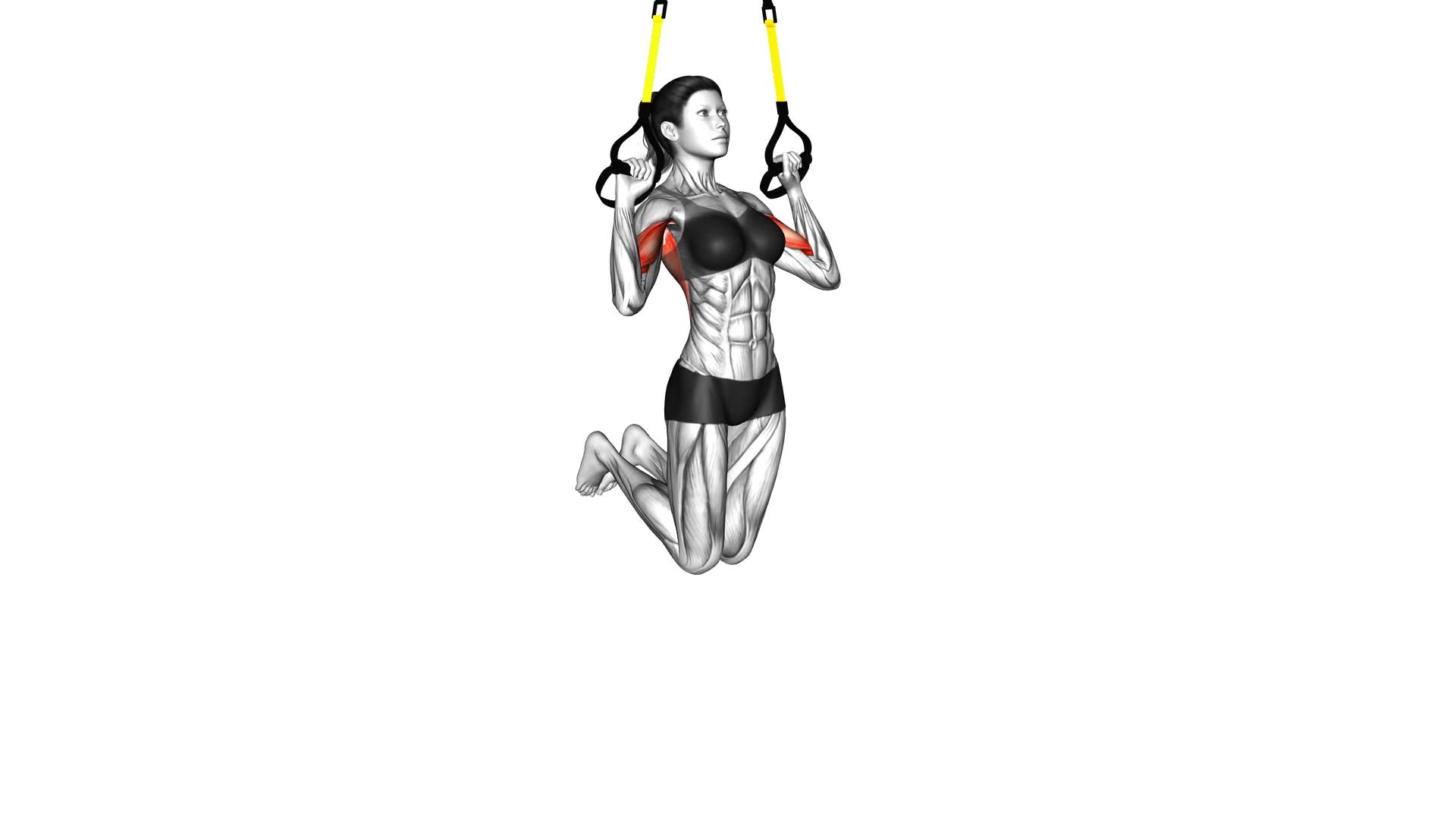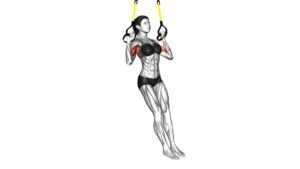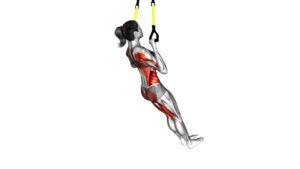Suspender Pull-up (female) – Video Exercise Guide & Tips

Looking to strengthen your upper body?
Watch This Exercise Video
In this video exercise guide, we've got you covered with the Suspender Pull-up.
With minimal equipment needed, you can easily perform this challenging exercise at home.
Learn the proper form and technique, along with modifications and progressions to suit your fitness level.
Avoid common mistakes and maximize your workout with these helpful tips.
Get ready to take your upper body strength to new heights with the Suspender Pull-up!
Key Takeaways
- Suspender Pull-up is an effective exercise for increasing upper body strength and toning the arms.
- This exercise targets the back, shoulders, and arms, engaging muscles such as the latissimus dorsi, deltoids, and biceps.
- Proper form and technique, such as maintaining a strong grip on the suspension straps and keeping the body straight, are crucial for maximizing the benefits of Suspender Pull-up.
- Modifications and progressions can be made to adapt the exercise for individuals with injuries or limitations, and adding resistance or incorporating variations can increase the challenge and variety of the workout.
Benefits of the Suspender Pull-up
One benefit of the Suspender Pull-up is that it helps increase your upper body strength and tone your arms. This exercise specifically targets the muscles in your back, shoulders, and arms, including the latissimus dorsi, deltoids, and biceps. By engaging these muscle groups, you can build strength and definition in your upper body.
Another advantage of the Suspender Pull-up is the variety of modification options available. Whether you're a beginner or an advanced exerciser, you can adjust the difficulty level to suit your fitness level. If you find pull-ups challenging, you can use resistance bands or a suspension trainer to assist you in completing the movement. On the other hand, if you're looking for a greater challenge, you can perform the exercise with added weight or by incorporating different grip variations.
Incorporating the Suspender Pull-up into your workout routine can have a significant impact on your overall fitness. Not only does it target multiple muscle groups, but it also promotes functional strength and improves your posture. So, if you're looking to strengthen your upper body and sculpt your arms, give the Suspender Pull-up a try and enjoy the benefits it has to offer.
Equipment Needed for the Exercise
To successfully perform the Suspender Pull-up exercise, there are a few essential pieces of equipment you'll need.
These include:
- A set of sturdy suspenders or resistance bands
- A pull-up bar or sturdy overhead structure to anchor them to
- A stable surface to stand on.
Investing in these cost-effective workout tools will allow you to effectively target your upper body muscles and achieve your fitness goals.
Essential Exercise Equipment
To perform the Suspender Pull-up (female) exercise, you'll need a few essential pieces of exercise equipment. The first and most important item is a set of suspenders or resistance bands. These will serve as your primary tool for the exercise, providing the necessary resistance to engage your muscles effectively.
Additionally, you'll need a sturdy overhead bar or a pull-up bar that can support your weight. Make sure it's securely installed and can handle your body weight to prevent any accidents or injuries.
Lastly, it's recommended to wear comfortable workout clothes and proper athletic shoes to ensure stability and minimize the risk of slipping.
With these exercise gear and workout essentials, you'll be ready to perform the Suspender Pull-up (female) exercise efficiently and safely.
Now, let's move on to the next section to explore some cost-effective workout tools.
Cost-Effective Workout Tools
To perform the Suspender Pull-up (female) exercise, you'll need cost-effective workout tools such as resistance bands and a sturdy overhead or pull-up bar. These cost-effective fitness equipment options provide an alternative to expensive gym memberships or bulky exercise machines.
Resistance bands are affordable and versatile, allowing you to adjust the resistance level based on your fitness level. They can be easily incorporated into various exercises, including the Suspender Pull-up (female).
A sturdy overhead or pull-up bar can be installed in your home or used at a local park, providing a solid base for performing the exercise. By opting for these cost-effective workout tools, you can achieve a challenging and effective workout without breaking the bank.
Now, let's move on to proper form and technique for the Suspender Pull-up (female).
Proper Form and Technique
Maintain a strong grip on the suspension straps as you pull yourself up in the suspender pull-up exercise, focusing on proper form and technique. Proper form is crucial in maximizing results and preventing common mistakes that can lead to injury or lack of progress.
First, make sure your hands are shoulder-width apart on the suspension straps, with your palms facing down. Engage your core and keep your body straight from head to toe. Avoid arching or rounding your back, as this can put unnecessary strain on your spine.
As you pull yourself up, aim to bring your chest towards the straps while keeping your elbows close to your body. This targets the muscles in your back, shoulders, and arms effectively. Avoid using momentum or swinging your body to complete the movement. Instead, focus on controlled and deliberate movements, using your muscles to pull yourself up.
To lower yourself back down, maintain control and resist the urge to drop quickly. Lower yourself with control until your arms are fully extended, then repeat the movement.
Remember to breathe throughout the exercise, inhaling as you lower yourself down and exhaling as you pull yourself up.
With proper form and technique, you can maximize the benefits of the suspender pull-up exercise and achieve your fitness goals more effectively.
Modifications and Progressions
Now let's talk about how you can modify and progress the suspender pull-up exercise.
There are different levels of difficulty that you can try based on your fitness level and strength.
If you have any injuries or limitations, you can adapt the exercise to accommodate them.
And if you want to challenge yourself even more, you can add resistance by using weighted vests or ankle weights.
Different Exercise Levels
As you progress in your fitness journey, you can modify and progress the Suspender Pull-up exercise to suit different exercise levels. To increase the difficulty and challenge your muscles further, you can try different progression levels.
For beginners, you can start with assisted Suspender Pull-ups using a resistance band or a partner to help you. As you gain strength and confidence, you can gradually reduce the assistance and work towards performing the exercise without any assistance.
To add variety to your workout routine, you can also incorporate exercise variations such as wide grip pull-ups, close grip pull-ups, or chin-ups. These variations target different muscles and can help you achieve a well-rounded upper body workout.
Remember to always listen to your body and progress at a pace that feels comfortable yet challenging for you.
Adapting for Injuries
To adapt the Suspender Pull-up exercise for injuries, you can modify the movement and progress at a pace that's comfortable for you. It's important to prioritize preventing injuries and supporting injury rehabilitation. Here are some tips to help you adapt the exercise:
- Listen to your body: Pay attention to any discomfort or pain during the exercise. If you experience any, modify the movement or reduce the intensity to avoid aggravating your injury.
- Consult a professional: If you're unsure about modifying the exercise on your own, seek guidance from a qualified fitness professional or a physical therapist. They can provide you with personalized modifications and progressions based on your injury and rehabilitation needs.
- Focus on alternative exercises: If the Suspender Pull-up is too challenging or puts too much strain on your injury, consider incorporating alternative exercises that target similar muscle groups without causing discomfort.
Adding Resistance for Challenge
To add resistance and increase the challenge of the Suspender Pull-up exercise, you can incorporate modifications and progressions that target your muscles more effectively.
One way to do this is by using resistance bands. Attach the bands to the suspenders and then to a sturdy anchor point above you. This will provide an additional challenge as you pull yourself up.
Another option is to use weight plates. Hold the weight plate between your feet or attach it to a weight belt around your waist. The added weight will make the exercise more difficult and help you build strength and muscle.
Remember to start with lighter resistance and gradually increase it as you get stronger.
Common Mistakes to Avoid
You should avoid rushing through the exercise and sacrificing proper form when performing the Suspender Pull-up. Taking the time to do it correctly won't only prevent injuries but also maximize the effectiveness of the exercise. Here are some common mistakes to avoid when executing the Suspender Pull-up:
- Using momentum: Swinging your body or using momentum to pull yourself up takes away from the targeted muscle engagement. Focus on controlled movements to fully activate the muscles.
- Neglecting the full range of motion: Make sure to fully extend your arms at the bottom of the movement and pull yourself up until your chin clears the bar. This ensures that you're working the muscles through their complete range of motion.
- Not engaging the core: Your core plays a crucial role in stabilizing your body during the exercise. Failing to engage your core can lead to strain on your lower back and limit the effectiveness of the exercise.
By avoiding these common mistakes and maintaining proper technique, you'll get the most out of your Suspender Pull-up workout.
Now, let's move on to the next section where we'll discuss some tips for maximizing your workout.
Tips for Maximizing Your Workout
To maximize the effectiveness of your Suspender Pull-up workout, focus on incorporating these tips into your routine.
- Pay attention to your form. Proper form is crucial for maximizing results and preventing injuries. Make sure to engage your core, keep your shoulders down and back, and maintain a straight line from your head to your heels.
- Vary your grip to target different muscle groups and increase workout intensity. Experiment with wide, narrow, and neutral grips to work your back, shoulders, and arms in different ways.
- Use resistance bands or weights to add resistance and challenge your muscles. This will help increase the difficulty of the exercise and maximize your strength gains.
- Don't forget to warm up and cool down properly. Warming up prepares your muscles for the workout and reduces the risk of injury, while cooling down helps with recovery and prevents muscle soreness.
Frequently Asked Questions
How Long Should I Hold Each Rep of the Suspender Pull-Up Exercise?
To properly perform the suspender pull-up exercise, you should aim to hold each rep for about 2-3 seconds. This will ensure that you're engaging the targeted muscles and maximizing the effectiveness of the exercise.
As for how long to rest between sets, a good rule of thumb is to rest for about 1-2 minutes. This will allow your muscles to recover and prepare for the next set.
To progress in difficulty, you can try increasing the number of reps or using a heavier resistance.
Can I Do the Suspender Pull-Up Exercise if I Have Lower Back Pain?
If you have lower back pain, it's important to avoid exercises that aggravate it. While the suspender pull-up may not be the best choice for you, there are alternative exercises that can target the same muscle groups without putting strain on your lower back.
However, if you don't have any lower back pain, the suspender pull-up can be a highly effective exercise that engages your back, shoulders, and arms.
Are There Any Alternatives to Using Suspenders for the Pull-Up Exercise?
If you're looking for alternative exercises to the suspender pull-up, there are a few options you can try.
One alternative is using resistance bands or a pull-up assist machine to help you build strength.
Another option is doing lat pull-downs, which target similar muscles.
However, it's important to note that using suspenders for the pull-up exercise can provide additional benefits, such as improved grip strength and increased muscle activation.
How Many Sets and Repetitions Should I Do for the Suspender Pull-Up Exercise?
To progress in the suspender pull-up exercise, start by doing two to three sets of 8 to 12 repetitions. As you get stronger, gradually increase the number of sets and reps. This will help improve your upper body strength and endurance.
Remember to warm up before each session and use proper form to prevent injuries. Take breaks as needed and listen to your body.
Stay consistent and you'll see progress in no time!
Can I Use a Chair or Step Stool to Assist With the Suspender Pull-Up Exercise if I Am Unable to Do a Full Rep?
If you're unable to do a full rep of the suspender pull-up exercise, using a chair or step stool can provide assistance. This modification allows you to build strength gradually.
Begin by standing on the chair or step stool and gripping the suspenders. Lower yourself down as far as you can, then use your legs to push back up.
As you progress, you can decrease the amount of assistance from the chair or step stool.
Conclusion
In conclusion, the suspender pull-up is a challenging exercise that offers numerous benefits for women. It helps to strengthen the upper body, improve grip strength, and increase overall muscle tone.
By using the proper form and technique, as well as making modifications and progressions as needed, you can maximize the effectiveness of this exercise. Remember to avoid common mistakes and follow the provided tips to get the most out of your workout.

Author
Years ago, the spark of my life’s passion ignited in my mind the moment I stepped into the local gym for the first time. The inaugural bead of perspiration, the initial endeavor, the very first surge of endorphins, and a sense of pride that washed over me post-workout marked the beginning of my deep-seated interest in strength sports, fitness, and sports nutrition. This very curiosity blossomed rapidly into a profound fascination, propelling me to earn a Master’s degree in Physical Education from the Academy of Physical Education in Krakow, followed by a Sports Manager diploma from the Jagiellonian University. My journey of growth led me to gain more specialized qualifications, such as being a certified personal trainer with a focus on sports dietetics, a lifeguard, and an instructor for wellness and corrective gymnastics. Theoretical knowledge paired seamlessly with practical experience, reinforcing my belief that the transformation of individuals under my guidance was also a reflection of my personal growth. This belief holds true even today. Each day, I strive to push the boundaries and explore new realms. These realms gently elevate me to greater heights. The unique combination of passion for my field and the continuous quest for growth fuels my drive to break new ground.







